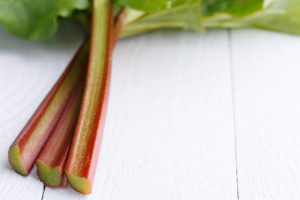Q. Is this a good time to plant Rhubarb? Does it grow better in the sun or the shade? Should I use a trellis or poles to support the stalks?

A. Rhubarb can be planted year-round, however January through May is when it’s widely available. Bare root divisions or clumps are found during the winter months while container plants are available in the spring. Rhubarb is grown in the open ground or in containers. They like a sunny location along the coast but must be protected from the heat of the day, summertime, and sun inland. For the average family of four, two to three plants will be plenty. The colorful stalks are the edible part of the plant. It’s important to note that the leaves, while safe to handle, are poisonous. To be successful growing Rhubarb, you should dig nice large holes and amend the native soil with homemade compost or soil conditioner at a 50-50 ratio. The plants are planted three to four feet apart and fed regularly with a slow release fertilizer like Osmocote, Dr. Earth or similar plant food. The fertilizer provides the necessary nutrients to encourage the new shoots from the base of the plant. They are rigid enough so it’s not necessary to provide any additional support. Rhubarb is harvested starting in April through the early summer. You should not harvest any stalks the first year and pick a small crop the second year. You’re in full production in the third year.
Rhubarb is harvested by grasping the stems firmly at the base of the plant and pulling them. The stalks should snap off cleanly. Avoid cutting any of the stalks as this could damage the plant. Every four-five years, during the winter months, Rhubarb is divided or when the clumps of stalks start to thin.
Q. Last summer, I planted purple fountain grass in the side yard and it’s now four feet tall. I was told that it can be cut way back. How often should this be done and how low can I go? Also, I was surprised when it turned brown. I thought it was an evergreen plant.
A. Fountain grass is an evergreen plant in mild climates. Here in the Bay Area, it is very common for it to turn brown from cold temperatures. It doesn’t have much tolerance to chilly nights. The cold is a descant that pulls moisture out of the foliage causing the leaves to burn or turn brown. Since our soils never freeze, the plant roots are not damaged. All the new growth will come from the base of the plant left in the ground. Once the foliage has turned brown, prune it off as close to the ground as you can get as they will never be green again. However, there is no great rush as the new growth is still a ways off. In March, with the days getting longer and warmer, fertilize with an all-purpose plant food to encourage the new shoots.
Leave a Reply